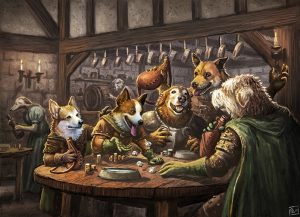For a long time, the number one question I got for Pugmire was “Can I play a cat?” But now that Monarchies of Mau is off to the printers, the new number one question I get is “Can I play as my favorite breed?”
The FAQ over at realmsofpugmire.com gives an answer for this. To wit:
Q: What dog breeds can I play? The breed I want to play isn’t in the right section.
A: Pugmire is designed to be a system that you can easily customize to your taste. You can play any breed of dog and assign her to one of the six game Breeds. If you don’t agree with what game Breed we’ve put a particular breed of dog in, feel free to change it in your game! Game Breeds are purely a mechanical development, and have very little impact on the Pugmire world.
That’s the simple answer, but it’s worth digging into the details a bit more, starting with how I came up with the Breeds in the first place.
As fans of D&D might realize, Breed fills the role of “race” mechanically, offering some special powers and an ability bonus. I knew that only having six breeds was bound to be controversial, because there are so many dog breeds past and present. As such, I thought I would use breed groupings as a way of organizing the material.
Oh, what a fool I was.
“This dog belongs in that group” was the single most prevalent category of open development comments I got. People had very strong opinions on what breed should be represented where. Worse, even in the real world there’s hardly a consensus on how to organize breeds. I quickly realized that I had to make a fictional distinction between breeds rather than relying on real world divisions. But even then, there were issues. What if a breed is both smart and fast? How do you measure stamina over strength? And aren’t all dogs worthy of a Charisma bonus for being so darned cute?
Then I got in contact with a professional dog breeder, and she gave me some great information. In particular, she mentioned that dog cognition involves inhibiting hunting behavior at some point along their chain (track, stalk, point/flush, chase, bite, kill, eat). That gave me a lot of clarity, and between us we were able to rearrange the breeds into their current forms. But it’s not perfect.
However, I never intended it to be perfect. As I point out in the FAQ, “Breed” is purely a mechanical construct. Families have in-game impact, but like our families, there can be diversity within a familial unit. Just because pugs tend to be cute and clownish doesn’t mean you can’t have a tough, serious pug. And some groups are going to have different opinions on which breeds should have what bonus.
Related, there are some canonical families that I’ve written. For example, I couldn’t find a version of “German Shepherd” that worked with my naming convention, so I use the alternative name “Alsatian” instead. Nearly all of the hounds have “-Hound” in their name, even dogs like “Fox-Hound,” but not all Hounds are necessarily in the same Breed groups. And I largely sidestep the issue of named mixed breeds — as far as I’m considered, it’s up to individual characters if they prefer to be known as a Puggle or a Mutt.
It’s all a bit of a mess, and that’s intentional. Family lines aren’t easy to backtrack, and I wanted to reflect that in the game. And that gives you some room to tweak and adjust things in your own way. So absolutely move the families around within the Breed breakdowns in whatever way makes sense for your game. In the end, as long as you’re having fun, that’s all that matters.

